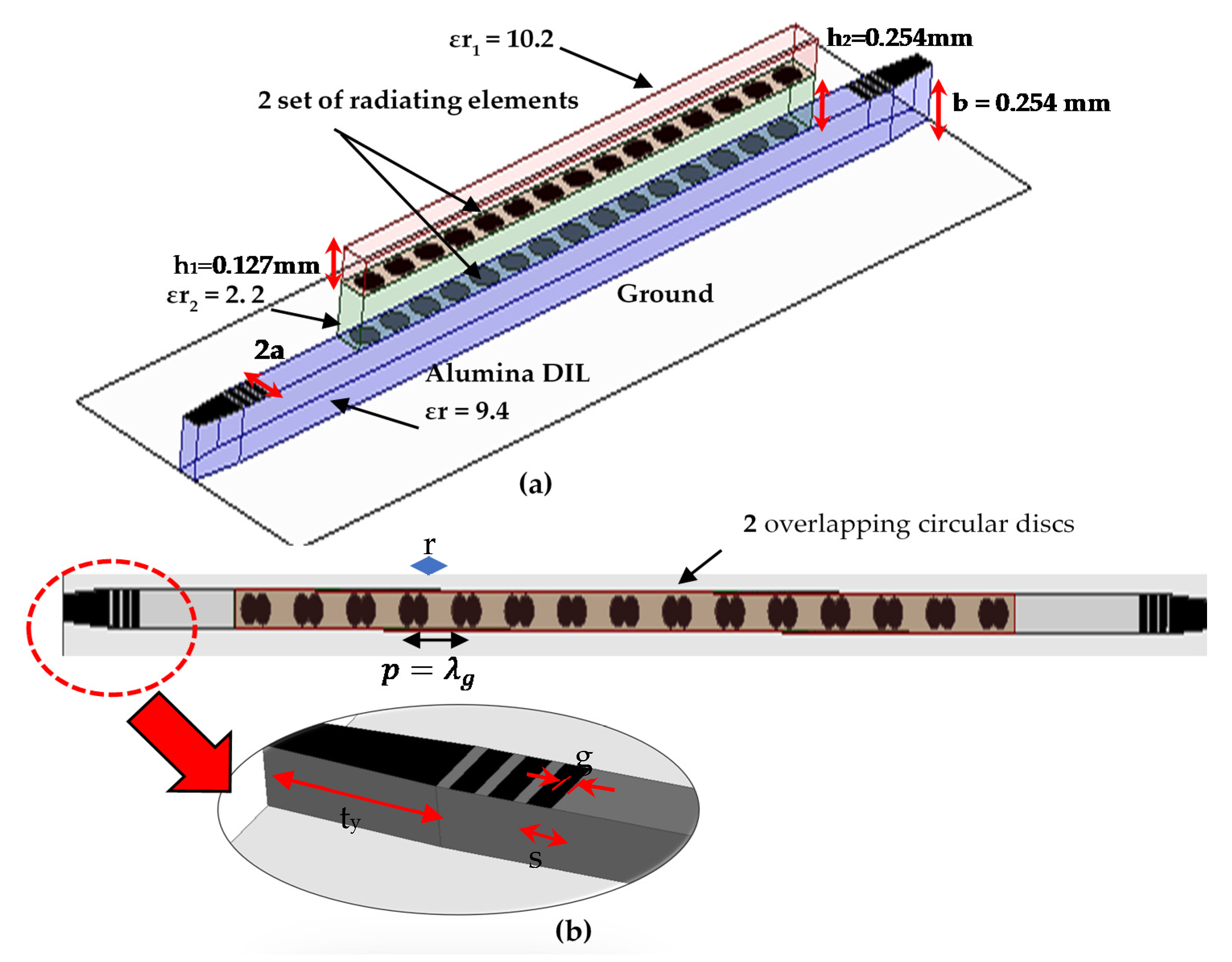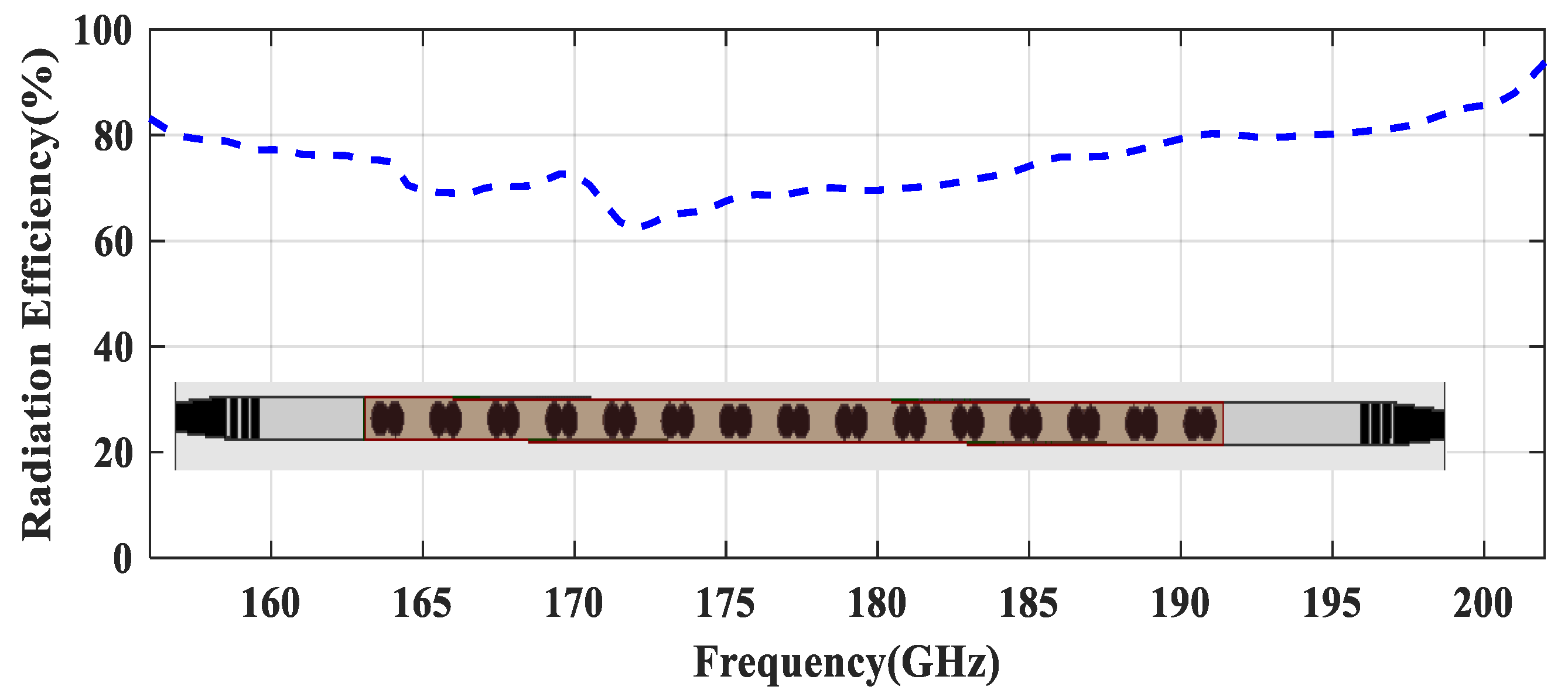A Wide-Angle Scanning Sub-Terahertz Leaky-Wave Antenna Based on a Multilayer Dielectric Image Waveguide
Abstract
1. Introduction
2. Antenna Array and Design Method
2.1. Radiating Element
2.2. Operation Mechanism and Leaky-Wave Generation
2.3. Feeding Network
3. Simulation Results and Discussion
4. Fabrication and Measurement Challenges
5. Conclusions
Author Contributions
Funding
Conflicts of Interest
References
- Gomez-Torrent, A.; Garcia-Vigueras, M.; Le Coq, L.; Mahmoud, A.; Ettorre, M.; Sauleau, R.; Oberhammer, J. A Low-Profile and High-Gain Frequency Beam Steering Subterahertz Antenna Enabled by Silicon Micromachining. IEEE Trans. Antennas Propag. 2019, 68, 672–682. [Google Scholar] [CrossRef]
- Matsumoto, H.; Watanabe, I.; Kasamatsu, A.; Monnai, Y. Integrated terahertz radar based on leaky-wave coherence tomography. Nat. Electron. 2020, 3, 122–129. [Google Scholar] [CrossRef]
- Rikkinen, K.; Kyosti, P.; Leinonen, M.E.; Berg, M.; Parssinen, A. THz Radio Communication: Link Budget Analysis toward 6G. IEEE Commun. Mag. 2020, 58, 22–27. [Google Scholar] [CrossRef]
- Kwon, H.; Kim, Y.; Yoon, H.; Choi, D. Selective Audio Adversarial Example in Evasion Attack on Speech Recognition System. IEEE Trans. Inf. Forensics Secur. 2019, 15, 526–538. [Google Scholar] [CrossRef]
- Brown, E.R. Fundamentals of Terrestrial Millimeter-Wave and THz Remote Sensing. Int. J. High Speed Electron. Syst. 2003, 13, 995–1097. [Google Scholar] [CrossRef]
- Golubiatnikov, G.Y.; Koshelev, M.A.; Tsvetkov, A.I.; Fokin, A.P.; Glyavin, M.Y.; Tretyakov, M.Y. Sub-Terahertz High-Sensitivity High-Resolution Molecular Spectroscopy with a Gyrotron. IEEE Trans. Terahertz Sci. Technol. 2020, 10, 502–512. [Google Scholar] [CrossRef]
- Guerboukha, H.; Shrestha, R.; Neronha, J.; Ryan, O.; Hornbuckle, M.; Fang, Z.; Mittleman, D.M. Efficient leaky-wave antennas at terahertz frequencies generating highly directional beams. Appl. Phys. Lett. 2020, 117, 261103. [Google Scholar] [CrossRef]
- Agarwal, R.; Agarwal, A.; Dwivedi, A.; Sharma, A. Leaky wave antenna for millimeter wave utilization. J. Phys. Conf. Ser. 2021, 1921, 012026. [Google Scholar] [CrossRef]
- Munawar, H.S. Applications of Leaky-wave Antennas: A Review. Int. J. Wirel. Microw. Technol. 2020, 10, 56–62. [Google Scholar] [CrossRef]
- Ghalibafan, J.; Hashemi, S.M. Leaky-Wave Centerline Longitudinal Slot Antenna Fed by Transversely Magnetized Ferrite. IEEE Trans. Magn. 2015, 52, 1–4. [Google Scholar] [CrossRef]
- Zheng, D.; Lyu, Y.-L.; Wu, K. Transversely Slotted SIW Leaky-Wave Antenna Featuring Rapid Beam-Scanning for Millimeter-Wave Applications. IEEE Trans. Antennas Propag. 2020, 68, 4172–4185. [Google Scholar] [CrossRef]
- Ranjan, R.; Ghosh, J. SIW-Based Leaky-Wave Antenna Supporting Wide Range of Beam Scanning through Broadside. IEEE Antennas Wirel. Propag. Lett. 2019, 18, 606–610. [Google Scholar] [CrossRef]
- Saghati, A.P.; Mirsalehi, M.M.; Neshati, M.H. A HMSIW Circularly Polarized Leaky-Wave Antenna With Backward, Broadside, and Forward Radiation. IEEE Antennas Wirel. Propag. Lett. 2014, 13, 451–454. [Google Scholar] [CrossRef]
- Chen, Y.; Wang, K.; Li, Y.; Long, Y. Periodic Microstrip Leaky Wave Antenna with Double-Sided Shorting Pins and Pairs of Slots. Int. J. Antennas Propag. 2020, 2020, 7101752. [Google Scholar] [CrossRef]
- Ros, A.J.M.; Gomez-Tornero, J.L.; Goussetis, G. Planar Leaky-Wave Antenna With Flexible Control of the Complex Propagation Constant. IEEE Trans. Antennas Propag. 2011, 60, 1625–1630. [Google Scholar] [CrossRef]
- Grbic, A.; Eleftheriades, G.V. Leaky CPW-based slot antenna arrays for millimeter-wave applications. IEEE Trans. Antennas Propag. 2002, 50, 1494–1504. [Google Scholar] [CrossRef]
- Alibakhshikenari, M.; Virdee, B.S.; Khalily, M.; Shukla, P.; See, C.H.; Abd-Alhameed, R.; Falcone, F.; Limiti, E. Beam-scanning leaky-wave antenna based on CRLH-metamaterial for millimetre-wave applications. IET Microw. Antennas Propag. 2019, 13, 1129–1133. [Google Scholar] [CrossRef]
- Pozar, D.M. Microwave Engineering, 4th ed.; Wiley: Hoboken, NJ, USA, 2011. [Google Scholar]
- Schwering, F.; Peng, S.-T. Design of Dielectric Grating Antennas for Millimeter-Wave Applications. IEEE Trans. Microw. Theory Tech. 1983, 31, 199–209. [Google Scholar] [CrossRef]
- Hammad, H.; Antar, Y.; Freundorfer, A.; Sayer, M. A new dielectric grating antenna at millimeter wave frequency. IEEE Trans. Antennas Propag. 2004, 52, 36–44. [Google Scholar] [CrossRef]
- Ma, Z.L.; Ng, K.B.; Chan, C.H.; Jiang, L.J. A Novel Supercell-Based Dielectric Grating Dual-Beam Leaky-Wave Antenna for 60-GHz Applications. IEEE Trans. Antennas Propag. 2016, 64, 5521–5526. [Google Scholar] [CrossRef]
- Prasad, C.S.; Biswas, A. Dielectric Image Line-Based Leaky-Wave Antenna for Wide Range of Beam Scanning Through Broadside. IEEE Trans. Antennas Propag. 2017, 65, 4311–4315. [Google Scholar] [CrossRef]
- Salman, A.O. On the antenna efficiencies for the dielectric leaky-wave antennas with a sinusoidal metallic diffraction grating coupled from the broad and the narrow face of the dielectric. Microw. Opt. Technol. Lett. 2011, 53, 2030–2034. [Google Scholar] [CrossRef]
- Prasad, C.S.; Biswas, A.; Akhtar, M.J. Leaky Wave Antenna for Wide Range of Beam Scanning through Broadside in Dielectric Image Line Environment. Microw. Opt. Technol. Lett. 2018, 60, 1707–1713. [Google Scholar] [CrossRef]
- Zandamela, A.; Al-Bassam, A.; Heberling, D. Circularly Polarized Periodic Leaky-Wave Antenna Based on Dielectric Image Line for Millimeter-Wave Radar Applications. IEEE Antennas Wirel. Propag. Lett. 2021, 20, 938–942. [Google Scholar] [CrossRef]
- Cheng, Y.J.; Guo, Y.; Bao, X.Y.; Ng, K.B. Millimeter-Wave Low Temperature Co-Fired Ceramic Leaky-Wave Antenna and Array Based on the Substrate Integrated Image Guide Technology. IEEE Trans. Antennas Propag. 2013, 62, 669–676. [Google Scholar] [CrossRef]
- Patrovsky, A.; Wu, K. Substrate Integrated Image Guide Array Antenna for the Upper Millimeter-Wave Spectrum. IEEE Trans. Antennas Propag. 2007, 55, 2994–3001. [Google Scholar] [CrossRef]
- Dey, U.; Tonn, J.; Hesselbarth, J. Millimeter-Wave Dielectric Waveguide-Based Leaky-Wave Antenna Array. IEEE Antennas Wirel. Propag. Lett. 2021, 20, 361–365. [Google Scholar] [CrossRef]
- Ostner, H.; Detlerfsen, J.; Jackson, D. Radiation from one-dimensional dielectric leaky-wave antennas. IEEE Trans. Antennas Propag. 1995, 43, 331–339. [Google Scholar] [CrossRef]
- Sharma, J.; De, A. Full-Wave Analysis of Dielectric Rectangular Waveguides. Prog. Electromagn. Res. M 2010, 13, 121–131. [Google Scholar] [CrossRef][Green Version]
- Fong, T.; Lee, S. Planar Dielectric Strip Waveguide for Millimeter-Wave Integrated Circuits. In Proceedings of the S-MTT International Microwave Symposium Digest, Atlanta, GA, USA, 12–14 June 1974; Volume 74, pp. 191–194. [Google Scholar] [CrossRef]
- Shindo, S.; Itanami, T. Low-Loss Rectangular Dielectric Image Line for Millimeter-Wave Integrated Circuits. IEEE Trans. Microw. Theory Tech. 1978, 26, 747–751. [Google Scholar] [CrossRef]
- Lalbakhsh, A.; Afzal, M.U.; Hayat, T.; Esselle, K.P.; Mandal, K. All-metal wideband metasurface for near-field transformation of medium-to-high gain electromagnetic sources. Sci. Rep. 2021, 11, 9421. [Google Scholar] [CrossRef]
- Mirmozafari, M.; Zhang, Z.; Gao, M.; Zhao, J.; Honari, M.; Booske, J.; Behdad, N. Mechanically Reconfigurable, Beam-Scanning Reflectarray and Transmitarray Antennas: A Review. Appl. Sci. 2021, 11, 6890. [Google Scholar] [CrossRef]
- Goudarzi, A.; Honari, M.M.; Gharaati, A.; Mirzavand, R. A Cylindrical Coaxial-fed Resonant Cavity Antenna with Off-axis Beaming for 5G Applications. In Proceedings of the 15th European Conference on Antennas and Propagation (EuCAP), Düsseldorf, Germany, 22–26 March 2021; pp. 1–4. [Google Scholar] [CrossRef]
- Afzal, M.U.; Matekovits, L.; Esselle, K.P.; Lalbakhsh, A. Beam-Scanning Antenna Based on Near-Electric Field Phase Transformation and Refraction of Electromagnetic Wave Through Dielectric Structures. IEEE Access 2020, 8, 199242–199253. [Google Scholar] [CrossRef]
- Al-Amoodi, K.; Mirzavand, R.; Honari, M.M.; Melzer, J.; Elliott, D.; Mousavi, P. Compact circularly-polarized SIW edge-radiating antenna for beamsteering in 5G mobile devices. In Proceedings of the 2018 IEEE International Symposium on Antennas and Propagation & USNC/URSI National Radio Science Meeting, Boston, MA, USA, 8–13 July 2018; pp. 1771–1772. [Google Scholar]
- Rahmani, M.H.; Deslandes, D. Backward to forward scanning periodic leaky-wave antenna with wide scanning range. IEEE Trans. Antennas Propag. 2017, 65, 3326–3335. [Google Scholar] [CrossRef]
- Lalbakhsh, A.; Esselle, K.P. Directivity improvement of a fabry-perot cavity antenna by enhancing near field characteristic. In Proceedings of the 17th International Symposium on Antenna Technology and Applied Electromagnetics (ANTEM), Montréal, QC, Canada, 10–13 July 2016; pp. 1–2. [Google Scholar]
- Nguyen-Trong, N.; Kaufmann, T.; Hall, L.; Fumeaux, C. Optimization of leaky-wave antennas based on non-uniform HMSIW. In Proceedings of the 2015 IEEE MTT-S International Conference on Numerical Electromagnetic and Multiphysics Modeling and Optimization (NEMO), Ottawa, ON, Canada, 11–14 August 2015; pp. 1–4. [Google Scholar]
- Lalbakhsh, A.; Afzal, M.U.; Esselle, K.P.; Smith, S. Design of an artificial magnetic conductor surface using an evolutionary algorithm. In Proceedings of the International Conference on Electromagnetics in Advanced Applications (ICEAA), Verona, Italy, 11–15 September 2017; pp. 885–887. [Google Scholar] [CrossRef]
- Zvolensky, T.; Ala-Laurinaho, J.; Simovski, C.R.; Räisänen, A.V. A Systematic Design Method for CRLH Periodic Structures in the Microwave to Millimeter-Wave Range. IEEE Trans. Antennas Propag. 2014, 62, 4153–4161. [Google Scholar] [CrossRef]
- Jamshidi, M.; Lalbakhsh, A.; Mohamadzade, B.; Siahkamari, H.; Mousavi, S.M.H. A novel neural-based approach for design of microstrip filters. AEU-Int. J. Electron. Commun. 2019, 110, 152847. [Google Scholar] [CrossRef]
- Lalbakhsh, P.; Zaeri, B.; Lalbakhsh, A.; Fesharaki, M.N. Antnet with reward-penalty reinforcement learning. In Proceedings of the 2nd International Conference on Computational Intelligence, Communication Systems and Networks, Liverpool, UK, 28–30 July 2010; pp. 17–21. [Google Scholar]
- Bhartia, P.; Bahl, I. Millimeter Wave Engineering and Applications; Wiley: New York, NY, USA, 1984. [Google Scholar]
- Liu, J. Periodic Leaky-Wave Antennas Based on Microstrip-Fed Slot Array with different Profile Modulations for Suppressing Open Stopband and n = −2 Space Harmonic. IEEE Trans. Antennas Propag. 2021, 1–13. [Google Scholar] [CrossRef]
- Guglielmi, M.; Jackson, D. Broadside radiation from periodic leaky-wave antennas. IEEE Trans. Antennas Propag. 1993, 41, 31–37. [Google Scholar] [CrossRef]
- Collin, R.E. Antenna Theory [by] Robert E. Collin [and] Francis J. Zucker (Inter-University Electronics Series); McGraw-Hill: New York, NY, USA, 1969; Volume 7. Available online: https://nla.gov.au/nla.cat-vn2086565 (accessed on 4 September 2021).
- Prasad, C.S.; Biswas, A. Broadband Planar Transition to Dielectric Image Line by Substrate Truncated Microstrip Line for Millimeter-Wave Circuit Integration. IEEE Microw. Wirel. Compon. Lett. 2017, 27, 533–535. [Google Scholar] [CrossRef]
- Ghasemi, A.; Laurin, J.-J. A Continuous Beam Steering Slotted Waveguide Antenna Using Rotating Dielectric Slabs. IEEE Trans. Antennas Propag. 2019, 67, 6362–6370. [Google Scholar] [CrossRef]
- Sarabandi, K.; Jam, A.; Vahidpour, M.; East, J. A Novel Frequency Beam-Steering Antenna Array for Submillimeter-Wave Applications. IEEE Trans. Terahertz Sci. Technol. 2018, 8, 654–665. [Google Scholar] [CrossRef]
- Patrovsky, A.; Wu, K. Substrate integrated image guide (SIIG)—A low-loss waveguide for millimetre-wave applications. In Proceedings of the 2005 European Microwave Conference, Paris, France, 4–6 October 2005; Volume 2. [Google Scholar] [CrossRef]
- Fang, P.; Wang, F.; Wirges, W.; Gerhard, R.; Basso, H.C. Three-layer piezoelectrets from fluorinated ethylene-propylene (FEP) copolymer films. Appl. Phys. A Mater. Sci. Process. 2010, 103, 455–461. [Google Scholar] [CrossRef]
- Liang, M.; Xin, H. Three-Dimensionally Printed/Additive Manufactured Antennas; Springer: Singapore, 2016; pp. 661–697. [Google Scholar] [CrossRef]







| Frequency Range (GHz) | Scanning Range (Degree) | Peak Gain (dBi) | Broadside Radiation | Size | Efficiency (%) | |
|---|---|---|---|---|---|---|
| [25] | 75–85 | −10°–8° | 12.7 | Yes | 11.1 λ0 | Not mentioned |
| [50] | 55 to 67 | Forward only 4°–18° | 6 | No | 12 λ0 | 79 |
| [51] | 230–245 | −25°–25° | 29 | Yes | 8 λ0 | 55 |
| [1] | 220–300 | Backward only −75°–−30° | 28.5 | No | 10 λ0 | 75.8 |
| [27] | 86–106 | −31°–10° | 11 | Yes | 6 λ0 | 58 |
| [26] | 58–67 | Forward only 7°–38° | 11.7 | No | 2.6 λ0 | 85 |
| This work | 157.5–206 | −23°–38° | 15 | Yes | 6.9 λ0 | 60 |
Publisher’s Note: MDPI stays neutral with regard to jurisdictional claims in published maps and institutional affiliations. |
© 2021 by the authors. Licensee MDPI, Basel, Switzerland. This article is an open access article distributed under the terms and conditions of the Creative Commons Attribution (CC BY) license (https://creativecommons.org/licenses/by/4.0/).
Share and Cite
Torabi, Y.; Dadashzadeh, G.; Hadeie, M.; Oraizi, H.; Lalbakhsh, A. A Wide-Angle Scanning Sub-Terahertz Leaky-Wave Antenna Based on a Multilayer Dielectric Image Waveguide. Electronics 2021, 10, 2172. https://doi.org/10.3390/electronics10172172
Torabi Y, Dadashzadeh G, Hadeie M, Oraizi H, Lalbakhsh A. A Wide-Angle Scanning Sub-Terahertz Leaky-Wave Antenna Based on a Multilayer Dielectric Image Waveguide. Electronics. 2021; 10(17):2172. https://doi.org/10.3390/electronics10172172
Chicago/Turabian StyleTorabi, Yalda, Gholamreza Dadashzadeh, Milad Hadeie, Homayoon Oraizi, and Ali Lalbakhsh. 2021. "A Wide-Angle Scanning Sub-Terahertz Leaky-Wave Antenna Based on a Multilayer Dielectric Image Waveguide" Electronics 10, no. 17: 2172. https://doi.org/10.3390/electronics10172172
APA StyleTorabi, Y., Dadashzadeh, G., Hadeie, M., Oraizi, H., & Lalbakhsh, A. (2021). A Wide-Angle Scanning Sub-Terahertz Leaky-Wave Antenna Based on a Multilayer Dielectric Image Waveguide. Electronics, 10(17), 2172. https://doi.org/10.3390/electronics10172172






